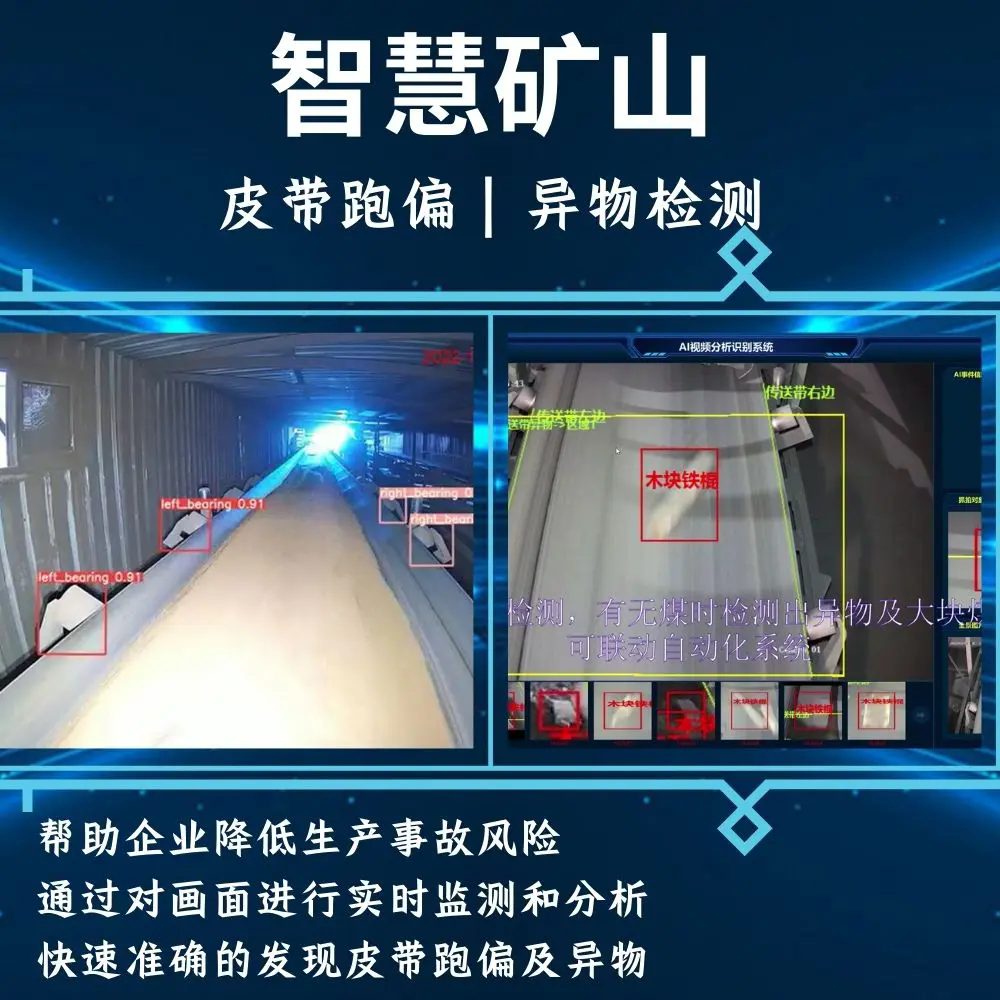The Impact of AI Intelligence on Mining Belt Conveyors in the Future
The Impact of AI Intelligence on Mining Belt Conveyors in the Future
AI intelligence has gradually entered an era of technological boom. In daily life, there are examples of using AI to optimize life everywhere. We can't help but wonder whether AI intelligence can enter the industrial field, combining steel behemoths with intelligence to achieve industrial super intelligence. Today, let's think about the impact of AI intelligence on mining belt conveyors in the future.

1.Improvement of Operating Efficiency
Real-time Monitoring and Fault Prevention
The AI algorithm uses high-precision sensors and visual recognition technology to capture the belt's operating status (such as deviation, no load, mixing of foreign material and etc.) in real time, achieve millisecond-level hidden danger warning and trigger automatic adjustment mechanism, reduce reliance on manual inspections, and reduce downtime.
Data-driven Energy Efficiency Optimization
Combining historical operation data with real-time collected parameters (speed, tension, load, and etc.), the AI model can predict the best operation mode of the belt conveyor, dynamically adjust the motor power and conveying rhythm, and reduce no-load energy consumption. This can reduce energy consumption on site and save equipment operating costs for owners.
2.Upgrade Security
Multi-dimensional Risk Warning
AI integrates video surveillance, environmental sensors and equipment operating data to build a comprehensive hidden danger identification system for "deviation - tearing - foreign objects - slipping".
Coordinated Management of Personnel Behavior and Environmental Safety
Through computer vision, we can identify behaviors such as not wearing safety equipment and crossing belts in violation of regulations, and simultaneously monitor environmental risks such as gas concentration and roof displacement, thus achieving “man-machine-environment” linkage warning.
3.Changes in Operation and Maintenance Model
AI analyzes equipment vibration, temperature and other parameters to predict hidden risks such as roller wear and bearing failure, generate spare parts replacement plans in advance, and reduce production losses caused by sudden failures.
Challenges and suggestions: At present, we still need to break through the algorithm generalization ability in complex geological environments and strengthen the data interoperability standards of cross-brand equipment. In the future, we need to deepen the integration of "AI + robots" to achieve fully automated operations in scenes such as belt conveyor cleaning and maintenance.
 O'zbek
O'zbek slovenský
slovenský Azərbaycan
Azərbaycan Қазақ
Қазақ Latine
Latine ລາວ
ລາວ български
български नेपाली
नेपाली فارسی
فارسی Javanese
Javanese Українська
Українська Lietuvos
Lietuvos Română
Română Slovenski
Slovenski پښتو
پښتو Punjabi
Punjabi Bosanski
Bosanski Malti
Malti Galego
Galego Afrikaans
Afrikaans Esperanto
Esperanto 简体中文
简体中文 Српски
Српски मराठी
मराठी Ελληνικά
Ελληνικά čeština
čeština Polski
Polski ไทย
ไทย Nederlands
Nederlands Italiano
Italiano Tiếng Việt
Tiếng Việt Deutsch
Deutsch français
français русский
русский Português
Português Español
Español 한국어
한국어 Svenska
Svenska Malay
Malay اردو
اردو norsk
norsk Indonesia
Indonesia عربى
عربى Gaeilge
Gaeilge Türk
Türk Pilipino
Pilipino हिन्दी
हिन्दी Dansk
Dansk বাংলা
বাংলা English
English


What is a Metering Conveyor
In modern material handling systems, efficiency and precision are critical to maintaining smooth operations. Among the many specialized conveyors used in industries such as packaging, food processing, mining, and logistics, the metering conveyor plays a vital role. But what exactly is a metering conveyor, and why is it becoming increasingly important in production environments?
Read MoreJuli Engineering Gains Global Recognition Among Mining Conveyor Manufacturers
The mining industry relies heavily on efficient material handling systems to ensure productivity and safety in large-scale operations. Among the many solutions available, mining conveyors stand out as indispensable equipment for transporting bulk materials such as ore, coal, and aggregates. As demand for advanced solutions grows, Juli Engineering has established itself as one of the most reliable mining conveyor manufacturers, offering durable, high-performance systems tailored to global mining needs.
Read MoreDesign and Application of a Comprehensive Coal Spillage Handling System for Downwards Transportation Belt Conveyor
A belt conveyor with an annual production capacity of 3 million tons is installed in a main inclined roadway with a steep angle of 22°. During operation, issues such as coal overflow, spillage, and falling coal occur, particularly when transporting raw coal with high moisture content.
Read More